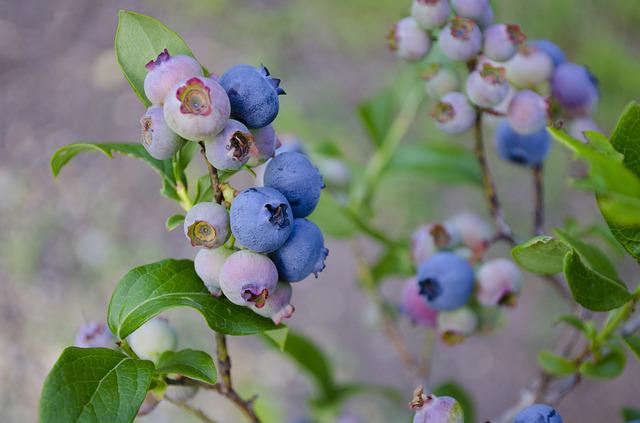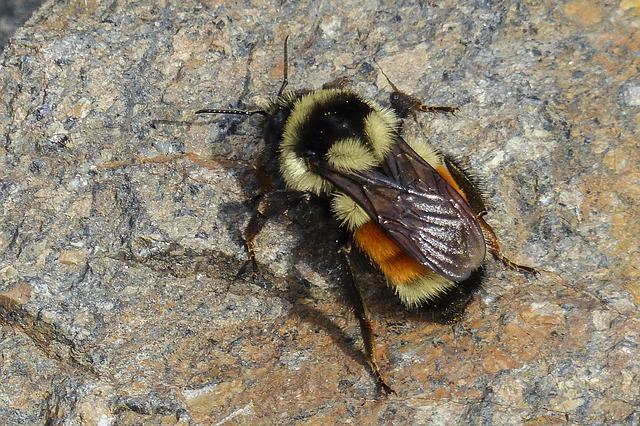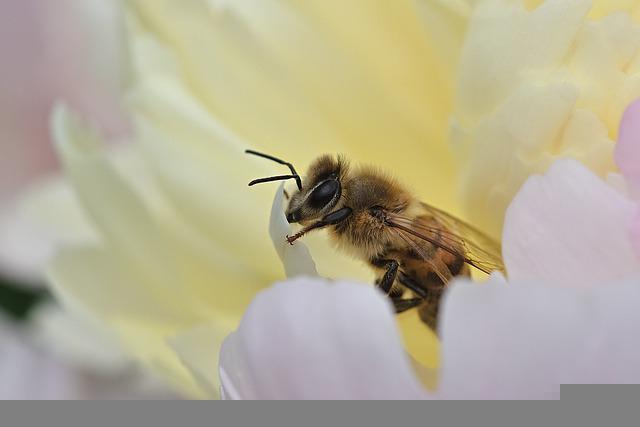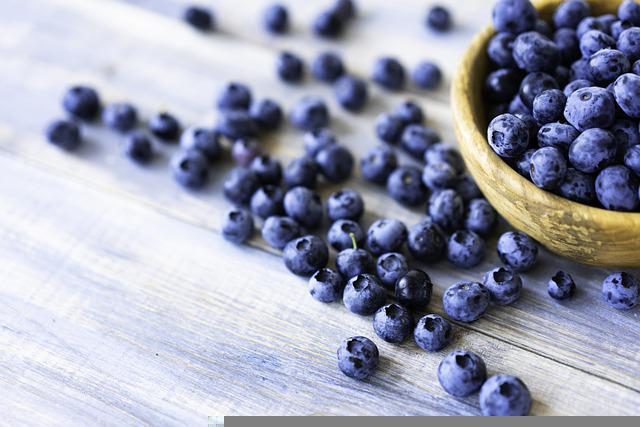How Are Blueberries Pollinated? All About the Process

Bees mainly pollinate blueberries. Pollination is the transfer of pollen from the anther (the male organ in the flower) to the pistil (the female organ). This process helps to produce seeds, and blueberry plants are no different! The flowers on blueberry bushes are both male and female parts, with the males located near the top of the plant and females situated near the base. When a bee visits a blossom, it will smell its way around until it comes across an anther that has been fertilized with pollen from another flower. Once it finds this area, it will insert its stinger into the petal, where they inject its venomous fluid, which contains enzymes that break down tissue to extract nectar.
After extracting this liquid nutrition, bees fly away and spread pollen wherever they go! This process happens multiple times during the flowering season as different flowers receive fertilization. So next time you’re out picking fruit or vegetables – thank your buzzing buddies for helping to ensure healthy crops! Keep on reading to know more about blueberry pollination.
Table of Contents
Pollination Factors
Weather
Weather influences pollination in several ways:
The 5–8 day flowering period can be shortened in hot weather, making pollen transfer more critical. In cold weather, pollinators may work less or less, and pollen tube growth may be slow. Poor pollination and fruit set can result. Pollinators work harder when it’s raining. The pollen grains can also fall off the stigma or burst from too much moisture.
The wind slows the bees, affecting pollination. Because of the flower shape and self-incompatibility, the wind is unlikely to play a role in pollination. Frost during flowering can damage the style and ovary, preventing pollen transfer. Poor yields are frequently blamed on frost but due to low pollinator activity. When a frost occurs, the pistil (style and ovary) turns black within hours.
Plant Vigor
Either genetically or due to poor soil fertility, weak plants are more likely to be unpollinated.
Clone Distribution
Large clones make uniform pollen transfer from the edges to the center of the clone difficult. Adding other clones to large clones can help.
Pollinating Insect Population
Insects pollinate flowers. The number of insects will thus influence the pollination rate. This is especially true in large fields. Native pollinators prefer the fields’ edges to the fields’ centers. Native pollinators seem inadequate for all but the tiniest fields. Native pollinators appear to contribute 10-20% of pollination, depending on field size and weather conditions during flowering. In most cases, managed pollinators are required.
Main Pollinators
Pollination is critical to wild blueberry production. The more pollen is transferred, the more likely the stigma will have enough compatible pollen grains to fertilize the ovules.
It may not be realistic to aim for a 75-100 percent fruit set due to too many genetic and environmental variables. Pollination rates of 40-60% are considered excellent. If the rate is below 30%, the pollinating force is inadequate.
The wind is useless for pollen transfer because pollen is too heavy and sticky. That leaves insects unless we can find a way to transfer pollen between clones mechanically.
We can look for pollination from four major groups of pollinators:
Bumble Bees
These solitary bees pollinate wild blueberries well. They pick a few flowers from one clone and then move on to the next. Sadly, their numbers are limited, and the commercialization of suitable insect species is still in its infancy.

Solitary Bees
This group includes a wide range of bees found in all fields. Their numbers fluctuate greatly from year to year. Small fields are thought to have more of them because they are more likely to survive. These bees are andrenids (miner bees) and halictids (honey bees) (sweat bees). The role of these insects in wild blueberry pollination is unknown.
Honey Bees
These bees pollinate wild blueberries well. According to recent research by de Oliveira (1994), large tracts of blueberry land near Lac St. Jean, Quebec, have direct yield-bee density relationships. The higher the bees’ concentration, the higher the yield. Low bee numbers reduced yield. Because wild blueberry nectar is scarce, bees thrive in areas with few alternative food sources. Strong hives produce the best results. Windbreaks can help honeybees by improving the micro-climate. There is a minimum stocking rate of 2.5 hives per hectare (1 hive per acre).
Leafcutter Bees
This bee’s use in wild blueberries is new. This bee has been shown to increase fruit set when properly stocked. Because these insects feed on pollen, the low nectar yield of wild blueberries does not affect them. They are also solitary and have a range of fewer than 100 meters (300 feet). When placed in wild blueberry fields, they do not seek other pollen sources. More on alfalfa leafcutter bees.
Other Wild Bees
Other types of wild bees, like sweat bees, mason bees, and mining bees, pollinate BC blueberry flowers much smaller than honey bees and bumblebees. Some of these bees live in the soil, while others, like old blueberry canes, live in holes and tunnels they’ve dug out of wood and plant stems.

Three Methods for Helping Bees
Make Sure Your Farm Is Surrounded by Natural Habitat and Plant More Flowers
Wild bees depend on flowering plants and nesting areas found in natural areas. For the bees and their offspring, flowering plants provide pollen and nectar. Bees benefit from a more varied diet because it keeps them active and healthy.
Reduce the Exposure of Pollinators to Pesticides
Utilize integrated pest management (IPM) to make pest management decisions. Avoid spraying during the crop’s bloom. If spraying is necessary, do so after dusk or dawn, when bees are not active in the field, using only products registered for use in bloom and avoiding tank mixes. Whenever possible, choose less toxic pesticides for bees.
Interact With Your Beekeeper
Create a contract outlining the expectations of both parties, and inform your beekeeper if you’ll be spraying in the vicinity of hives.
Wild Blueberries Pollination
When talking about how wild blueberries get pollinated, there are two important words: pollination and fruit set.
Pollination
Pollination happens when pollen moves from the male stamens of a flower to the female pistil of the same flower species. This makes the fruit fertile.
Fruit Set
This word means the number of flowers that turn into fruit. Some people use the terms percent fruit set and percent pollination interchangeably.
Pollination Process
Pollen transfer is the first step in the process of pollination. Insects move pollen from the anthers to the stigma at the end of the style when they visit flowers. The pollen grain(s) grow into a pollen tube on the stigma, which goes down to the ovary and fertilizes the ovule (s). When an egg is fertilized, it grows into a seed. For a fruit to be good, it needs several fertilized ovules. This means that pollen needs to move between flowers often.
Degree of Pollination
The number of healthy seeds set directly affects how the fruit grows. Aalders wrote in 1958 that every blueberry fruit should have at least 6–10 seeds that can grow. If there are fewer than six seeds, the fruit may be small or fall off before ready. He said that each extra seed makes the fruit 5 percent heavier and brings the time it is prepared to eat forward by half a day. These seeds make “hormones” that act like magnets to pull the plant’s resources to the fruit and make it grow bigger. The fruit will be bigger and better able to handle heat and water stress if there are more viable seeds. When growing conditions aren’t good, fruits with few seeds that can grow will stay small and may die or not grow at all. The yield will go up no matter what you do to increase the number of good seeds in the fruit. A small blueberry has less than eight good seeds, a medium-sized blueberry has between 10 and 15, and a large blueberry has between 16 and 18 good seeds.

Wild Blueberry Pollination Genetic Factors
- Self-Incompatibility: Normally, flowers on the same plant can’t pollinate each other. Pollen must be moved from one clone to another for fertilization to happen. Only a small number of clones can produce fruit from their pollen.
- Fertility: Research has shown that about 5% of wild blueberry plants are male-sterile, which means they don’t have stamens and can’t make pollen.
- Pollen-Making Ability: Nearly 45 percent of plants make little or no pollen, limiting the amount of pollen used to pollinate.
- Incompatibility Between Species: A field can have up to five different kinds of blueberries. The most common species are the low sweet (Vaccinium angustifolium) and the sour top (Vaccinium myrtilloides). If top sour pollen fertilizes the low sweet, the fruit will abort in twelve days. When both species are in the same field, the fruit is smaller, and there are fewer seeds that can grow.
Genetic factors can be very important and show how important it is to manage pollination well.
Integrated Pollination of Crops
Bee species and pollination management techniques can be combined to ensure that crops are pollinated reliably. Depending on the time of day or the stage of crop bloom, different species of bees may visit flowers at different times. Flowers are also handled differently by each group. Unlike honey bees, which cannot “buzz,” bumblebees vibrate blueberry flowers to remove pollen more effectively. Pollination in your fields will be more reliable if you have a wide variety of pollinators. Pollination can suffer in the spring when unseasonably cool, rainy, and windy weather. On days with bad weather, more flowers will be visited if multiple pollinator species are active. Butterflies and other big-bodied bees, like bumblebees, are better at pollinating crops in cool, cloudy spring weather than honeybees.
Both wild and domesticated bees benefit from getting to flowering plants that give them lots of pollen and nectar. Keeping the area around your farm natural gives the wild bees that pollinate your crops places to live and food to eat. This is very important for bumblebees, which are busy from the time crops bloom in early spring until the end of summer. Plant or encourage a mixture of flowering shrubs, trees, and wildflowers if there isn’t much natural habitat near your farm. This will give wild bees blooms throughout the season and help them survive.
References:
Blueberry Pollination (n.d.) http://icpbees.org/wp-content/uploads/2014/05/BC-Blueberry-Pollination-Factsheet-Final.pdf
Pollination of Wild Blueberries. (n.d.). Pollination of Wild Blueberries; www2.gnb.ca. Retrieved May 11, 2022, from https://www2.gnb.ca/content/gnb/en/departments/10/agriculture/content/crops/wild_blueberries/pollination.html
